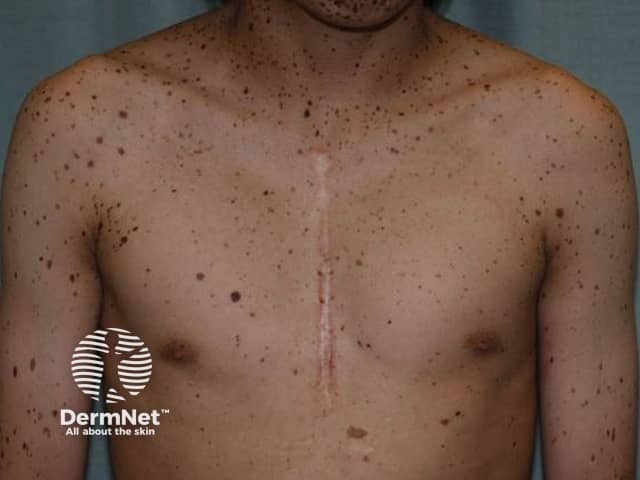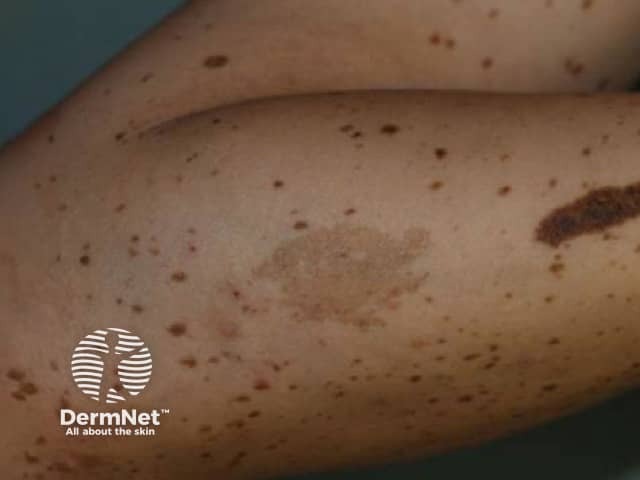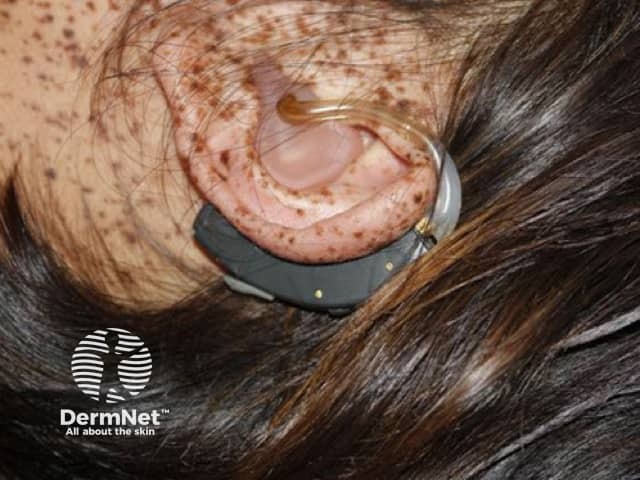Main menu
Common skin conditions

NEWS
Join DermNet PRO
Read more
Quick links
Noonan syndrome with multiple lentigines — extra information
Noonan syndrome with multiple lentigines
Author: Vanessa Ngan, Staff Writer, 2006. Updated by Dr Jonathan Chan, RMO, Waikato Hospital, 2017.
What is Noonan syndrome with multiple lentigines?
Noonan syndrome with multiple lentigines (NSML), formerly known as LEOPARD syndrome, is a very rare inherited disorder that is characterised by skin, heart, ear, genital, head and facial abnormalities. It is one of a group of syndromes collectively known as RASopathies.
The mnemonic LEOPARD describes these characteristic abnormalities associated with the disorder.
- L – lentigines (multiple brown-black spots on the skin)
- E – electrocardiographic (ECG) conduction defects
- O – ocular hypertelorism
- P – pulmonary stenosis
- A – abnormalities of genitals
- R – retarded growth resulting in short stature
- D – deafness or hearing loss due to inner ear malfunction

LEOPARD syndrome

LEOPARD syndrome

LEOPARD syndrome
What are the clinical features of NSML?
Noonan syndrome with multiple lentigines is similar to the condition Noonan syndrome, with the two syndromes being difficult to discern from one another in early childhood. The characteristic dermatological features of each variant develop from later childhood to early teens.
The clinical features of Noonan syndrome with multiple lentigines vary considerably between patients, with most only manifesting 3–5 abnormalities. Lentigines are the most common feature of the syndrome and occur in more than 90% of patients. However, they do not have to be present to diagnose the syndrome.
The lentigines are small, dark pigmented flat or slightly raised lesions with well defined borders.
- Often 2–5 mm in diameter, some lentigines may grow to 1–1.5 cm in size.
- They are an irregular round or oval shape.
- Unlike freckles, these spots are not affected by sun exposure.
- They are often found on the face, neck, and upper part of the trunk but also on the palms, soles, and the sclerae (whites) of the eyes.
Other skin abnormalities include:
- Freckling around the armpit region
- Café au lait macules (coffee-coloured flat macules)
- Localised hypopigmentation (lightening of skin colour)
- Onychodystrophy (malformation of the nails)
- Interdigital webs (webbing between the fingers)
- Hyperelastic skin (stretchy skin)
Non-cutaneous features of Noonan syndrome with multiple lentigines include:
- Hearing loss in about 25% of patients
- Short stature in about 1/3 of patients
- Mild degree of intellectual disability in about 30% of patients
- Craniofacial abnormalities (eg, low set ears, abnormal shaped skull, dental abnormalities)
- Abnormalities of the genitals in about 26% of patients, mainly in men
- Heart abnormalities, often without symptoms
What causes NMSL?
Noonan syndrome and Noonan syndrome with multiple lentigines are classed as RASopathies. They are due to mutations in genes associated with the RAS/MAPK cell signalling pathway. These mutations lead to dysregulation of cell division and differentiation.
Approximately 75% of patients with Noonan syndrome with multiple lentigines carry mutations in the PTPN11 gene (protein-tyrosine phosphatase, nonreceptor type 11). Ten percent have mutations in the RAF1 gene. In rare cases, mutations in BRAF and MAP2K1 genes are implicated.
Noonan syndrome with multiple lentigines is inherited in an autosomal dominant manner, which means that if one parent is affected there is a 50% chance that each child will be affected. About 70% of cases have a family history. The remainder are sporadic cases occurring from new mutations.
The signs and symptoms experienced by people with Noonan syndrome with multiple lentigines vary greatly. Some patients may have a partial form of the syndrome and suffer mild symptoms while others with the full syndrome are more severely affected.
How is NSML diagnosed?
Diagnosis based on clinical features. Noonan syndrome with multiple lentigines should be suspected in patients who demonstrate one or more of the following cardinal features:
- Lentigines
- Cardiac abnormalities
- Short stature
- Pectus deformity
- Facial dysmorphia.
Proposed minimum criteria are:
- The presence of multiple lentigines, plus 2 other cardinal features
- If lentigines are absent, a first degree relative with a diagnosis of Noonan syndrome with multiple lentigines plus 3 of the cardinal features.
Diagnosis may be based on molecular genetic testing. Single gene or multi-gene panels can be used to identify mutations.
What treatments are available?
A team of specialist doctors including a cardiologist, endocrinologist, orthopaedist and dermatologist should manage Noonan syndrome with multiple lentigines.
If necessary, isolated lentigines can be removed through the use of chemical peels, cryotherapy, laser treatments or surgical excision. For some patients, treatment with topical retinoids and hydroquinone cream may be helpful.
References
- OMIM – Online Mendelian Inheritance in Man (search term LEOPARD syndrome)
- Book: Textbook of Dermatology. Ed Rook A, Wilkinson DS, Ebling FJB, Champion RH, Burton JL. Fourth edition. Blackwell Scientific Publications.
- Sarkozy A, Obregon M, Conti E, Esposito G, Mingarelli R, Pizzuti A et al. A novel PTPN11 gene mutation bridges Noonan syndrome, multiple lentigines/LEOPARD syndrome and Noonan-like/multiple giant cell lesion syndrome. European Journal of Human Genetics. 2004;12(12):1069–72. PubMed.
- Noonan syndrome with multiple lentigines [Internet]. Genetics Home Reference. 2017 [cited 14 June 2017]. Available from: https://ghr.nlm.nih.gov/condition/noonan-syndrome-with-multiple-lentigines
On DermNet
Other websites
- LEOPARD syndrome — Medscape Reference
- LEOPARD syndrome — US National Library of Medicine Genetics Home Reference
